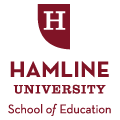Term
Spring 5-2017
Capstone
Thesis
Degree Name
MAESL
Primary Advisor/Dissertation Chair
Anne Rogan
Secondary Advisor/Reader One
Bridget Erickson
Peer-Reviewer/Reader Two
Rachelle Kreuser
Abstract
The purpose of this study was to determine the frequency of bound morphemes in science texts used in K-12 classrooms. The motivating factor for this capstone was to better understand why so many students struggle with the increased demands of academic language and unfamiliar vocabulary in science texts. Bound morphemes were chosen as the focal point because they appear frequently in academic language. A familiarity with bound morpheme structures helps readers to access unfamiliar words, which aids in reading comprehension (Kieffer & Leasaux, 2008). A quantitative research method was used and a random sampling of science books, one from each grade level, were analyzed. The frequency of inflectional and derivational morphemes was recorded. The major findings from this study were that bound morphemes generally increase in frequency by grade level. Further analysis showed how derivational morphemes became more prevalent than inflections in several higher-grade level texts.
Recommended Citation
Koch, Matthew, "A Text Analysis Of Bound Morphemes In K-12 Science Texts And The Implications Of Bound Morphemes For English Language Learners’ Reading Comprehension" (2017). School of Education and Leadership Student Capstone Theses and Dissertations. 4549.
https://digitalcommons.hamline.edu/hse_all/4549
dc_type
text
dc_publisher
DigitalCommons@Hamline
dc_format
application/pdf
dc_source
School of Education Student Capstone Theses and Dissertations

